Written by Terry Smith
Our site is reader supported so when you click a link to Amazon we may earn an affiliate commission.
UK’s best lawn spreaders tested: Evergreen, Scotts, and Gardena
This article was last updated on April 21st, 2022 at 8:29 am
Creating the perfect lawn takes time and effort. It’s not just a case of planting grass seed and waiting for the sun and rain to do their jobs. In an earlier article I showed you how to make and level a lawn from scratch. This time I just need some grass seed down for the kids to play on as we are going to do a major landscape project and I got lazy. I’ll admit it. I sent the kids around with a bag and handfuls of grass seed. It was a washout 😀 (the UK almost always is!). The lawn is completely patchy – and in fairness, the birds got their share of my seed but it would have still been a problem. So this time, armed with more seed, and the best lawn spreader I am testing and showing you how much more accurate a lawn spreader really is as opposed to hand seeding. In fact that’s a bit misleading – my daughter is going to demonstrate for you 🙂

Enter the EverGreen 18920 Easy Spreader Plus – it was the best value and quality in testing by far for my money – even my 9 year old daughter used it with ease! She covered about 160m2 of garden in 15 minutes, tested, and proven! And as a result of my testing, there’s a new top pick:
Best lawn spreader in the UK: top picks from my personal testing:
- EverGreen 18920 Easy Spreader Plus (best cheap wheeled lawn feed spreader)[personally tested and proven]
- Scotts EasyGreen Rotary spreader (best for large gardens) [personally tested and proven – heavy duty pick]
- Einhell GE-US Power X-Change Lawn Feed Spreader (best battery powered lawn feed spreader) [personally tested and proven]
- Gardena Hand-Held Spreader
- The Handy 50lb Wheeled Lawn and Fertiliser Spreader – Professionals choice and designed for commercial / heavy duty work
- Scotts EvenGreen Drop spreader
- Gardena Spreader XL: Universal Spreader for Delivering Fertiliser
- Greenkey Deluxe Seed and Fertiliser Spreader On a budget, not bad alternative
Lawn spreader testing
So to ensure we really are bringing you the best products I am testing a new lawn spreader this time. You may recall when I levelled my first garden a couple of years ago I used the Scotts EasyGreen Rotary spreader. This time I am bringing you the EverGreen 18920 Easy Spreader Plus. Fundamentally the performance was very similar, but you just can’t ignore the overall cost difference with the latter being not far off just half the price – it’s easy to see why it’s the best seller online by a long way! Anyway, let’s have a look at the testing process.
How to setup a lawn spreader
First things first, your lawn spreader rocks up in an intimidating box that clearly needs setup but don’t panic, it’s a very minimalistic process and I’d say you’ll be up and running in a matter of minutes – very minimal DIY skills are required. Here’s a look at that box, it is cumbersome but weighs just a few kilos:
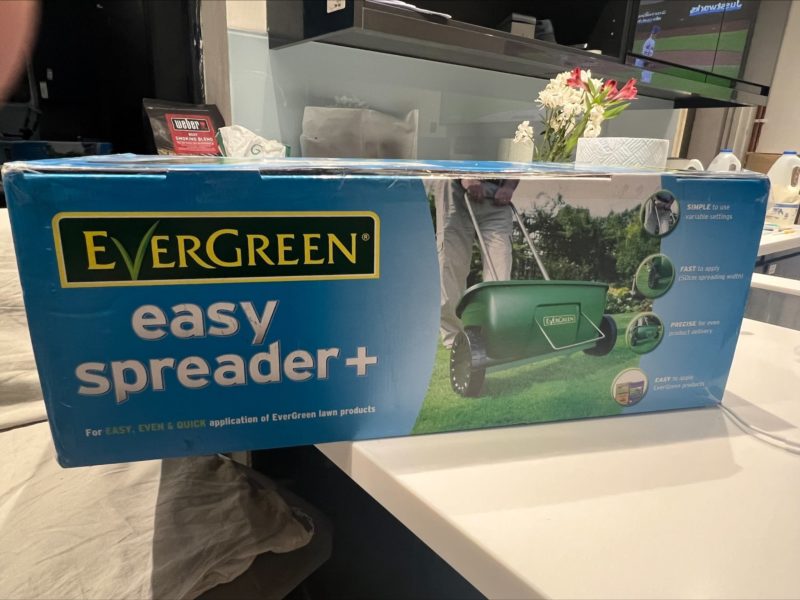
After removing your packaging you are left with just a few obvious bits to assemble – here’s a look at the contents laid out a bit better – only a few pieces that need to be slotted together:
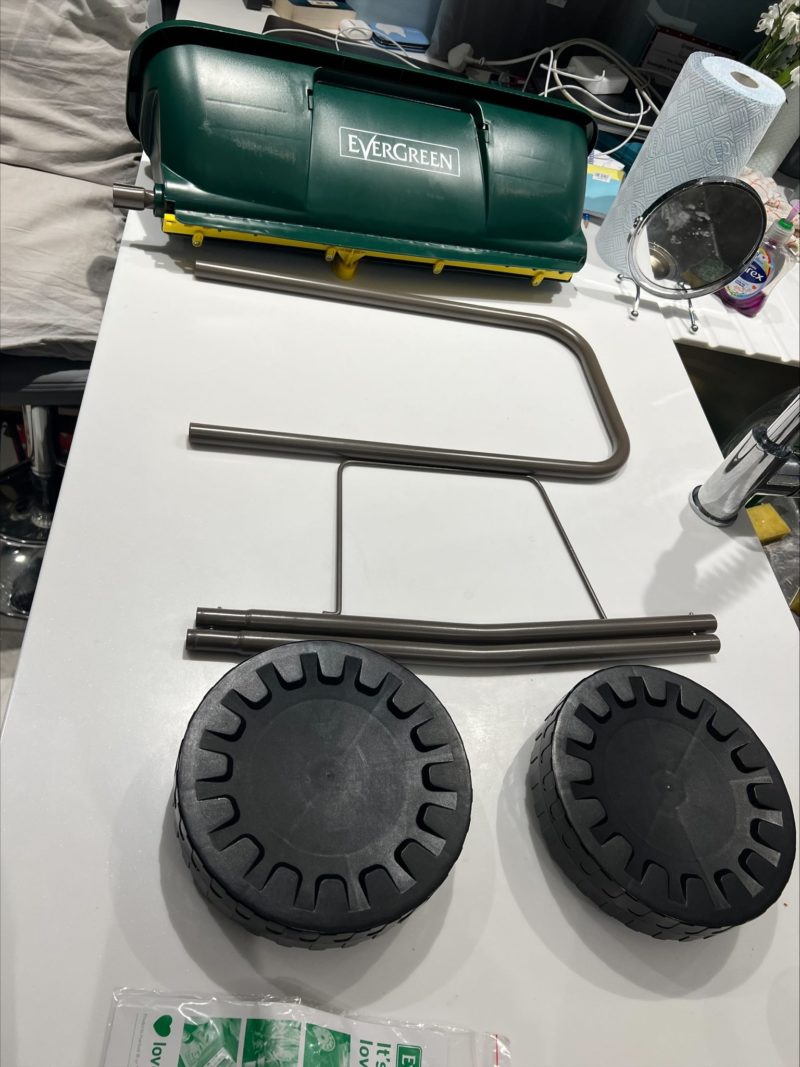
All the parts just push fit together the wheels push on easily, the handle and extensions are all riveted together and slot in. I would say pushing those bits all together took me less than two minutes quite honestly. Here’s a look at that:
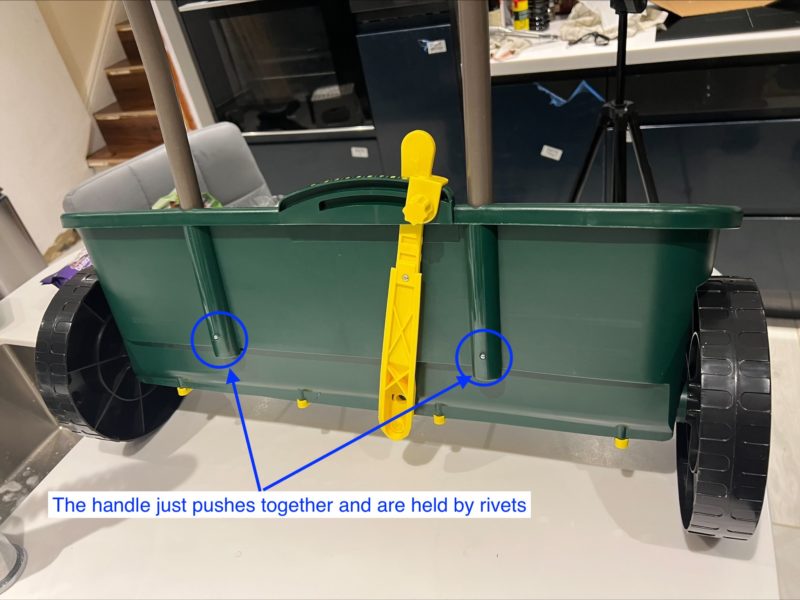
If you want to see a quick video of that process please look here – I have set the timer to the assembly section for you:
But that’s it really – fully assembled in minutes and ready to start spreading lawn feed or grass seed!
Testing lawn spreaders
So test test I have taken into consideration a few important elements. How much material can be held, how well the spreader distributes seed and fertiliser, price, durability, and hopper capacity. I start with grass seed on a lawn that was hand seeded and ended up patchy – without question, when factoring the method I have used to test these lawn spreaders, for a little garden like mine, EverGreen Easy Spreader Plus came out on top – even a child could successfully spread seed with this spreader it was that easy. And setup was a doddle too. Here’s a couple of pictures of the spreader in use:
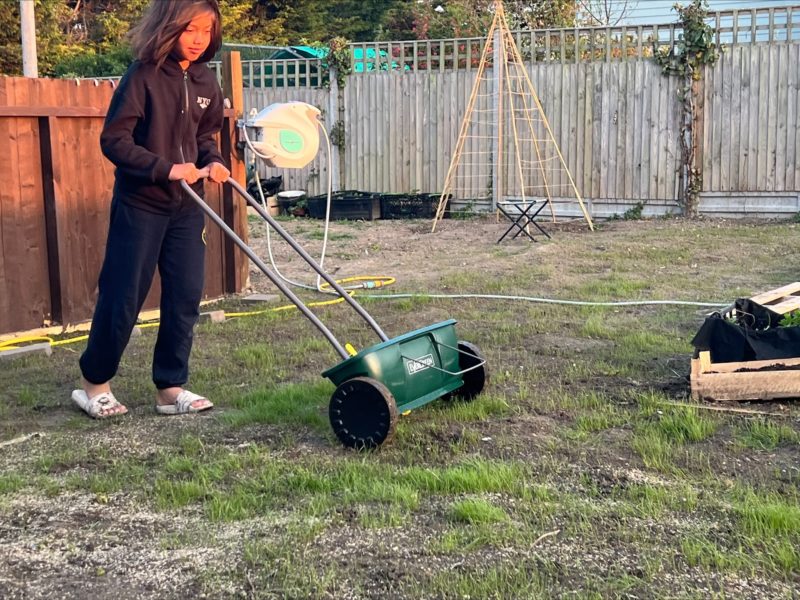
Let’s take a look at all the spreaders in this article now:
1. EverGreen 18920 Easy Spreader Plus
Specification: Spreading width: 53 cm, Capacity: N/A, Recommended lawn area: least 100 m², When to use: March to November
Whether you’re applying lawn feed or reseeding a lawn to bring it back to its best, the EverGreen Easy Spreader Plus can help you get the job done in half the time, and ensure that you are getting a more accurate distribution too – that’s what I’ve learned from personal testing. You’ll notice it’s miles better than a hand spreader and the only real competition it has is the Scotts when directly compared. Before we get started here’s a quick video that demonstrated why I rate this the best lawn spreader in the UK at the moment.
This is a drop feeder, and so it is far easier to control the spread of the seed than with a rotary lawn feed spreader, and that’s good news for your borders and beds.
The EverGreen gives you a lot of control over the spread rate too, through multiple settings that can be adjusted using the easy-to-reach plastic controls on the back of the feeder. Not only that, but it is quick and easy to stop the flow, and start it again, for when it comes to do a 180 degree turn and head the other way- no more large piles of feed in certain spots on your lawn.
I have to be honest and say that I wish that Evergreen had used metal for the spread controls instead of plastic, but as long as you’re not super heavy-handed, the plastic is decent enough quality not to break easily. The adjustment is very simple, the higher the number, the wider the holes in the bottom of the hopper – when set to 9 you can see cear daylight through and will be releasing a lot of seed or feed:
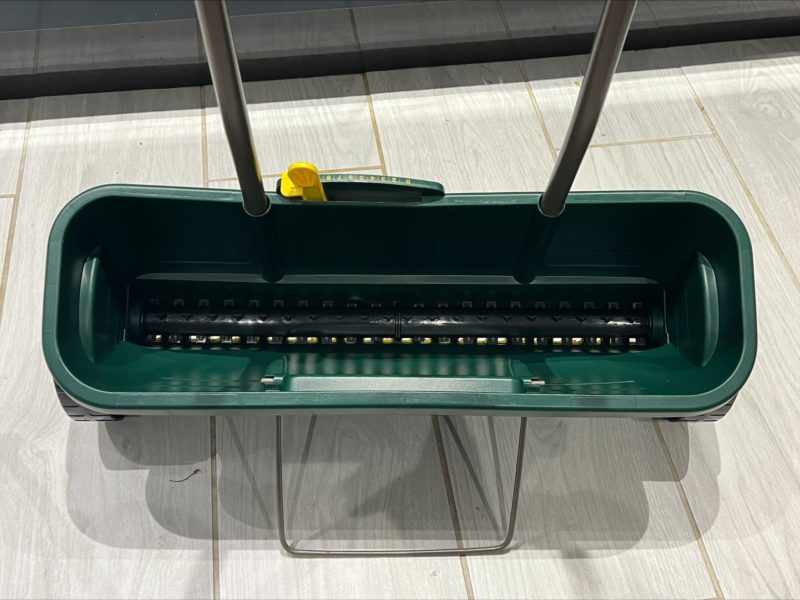
By contrast set to 0 is practically closed, ideal if you’re loading up in the shed and then walking your unit to your lawn – this makes keeping your seed and fertiliser in the shed all the easier:
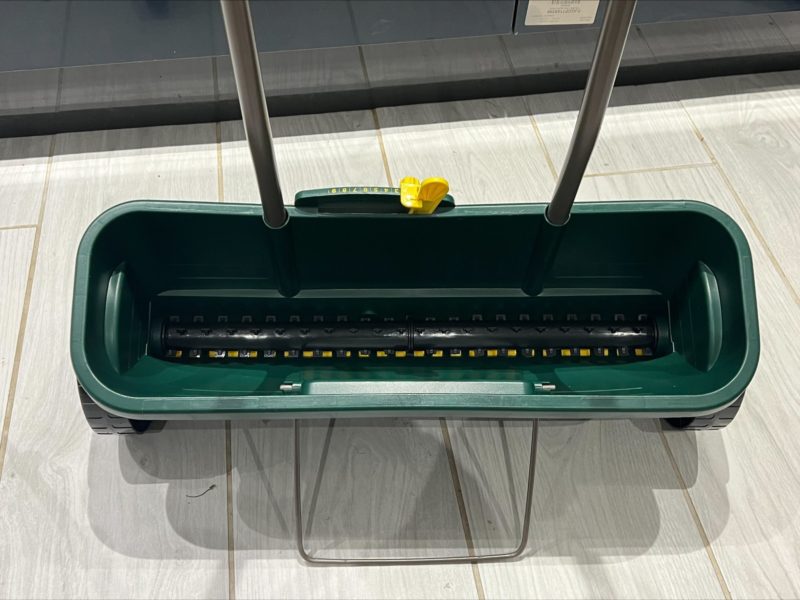
To use this product at its optimum, Evergreen suggests that you walk at a pace of about 1 metre per second, but going a little slower had no noticeable negative effects, so don’t worry if you’re not exactly the Usain Bolt of the gardening world. But this is subjective as the wheels are directly connected to the turnstile so if you walk slower you’ll get the same release I found from testing, so not quite sure what they mean – just take your time – the speed my daughter demos worked absolutely fine for seed…
There are also directions given for using the best spread rate settings with various types of EverGreen granular products too.
This is a well-constructed product, and when compared to the well know Scott Easy Green, it more than holds its own. That’s not too bad at all for a product that costs significantly less.
You won’t need a degree in engineering to assemble this lawn feed spreader either. In fact, it’s a doddle to put together and will only take 2 minutes as you can see from my video. In fact, it took me longer to cut the lid open than the actual setup process 😀
The one thing I will say against the EverGreen lawn feed spreader is that, at least at first, the wheels were quite stiff and needed a good spraying of oil, and some practice runs across the lawn to loosen them up. Even after this, when compared with the Scott products, they still didn’t feel as smooth off the bat but about 15 minutes in everything clicked together – I guess it’s just a bit tight. The spread of the seed and fertiliser is unquestionably good, here’s a look – you can see in the pic below or check my video again:
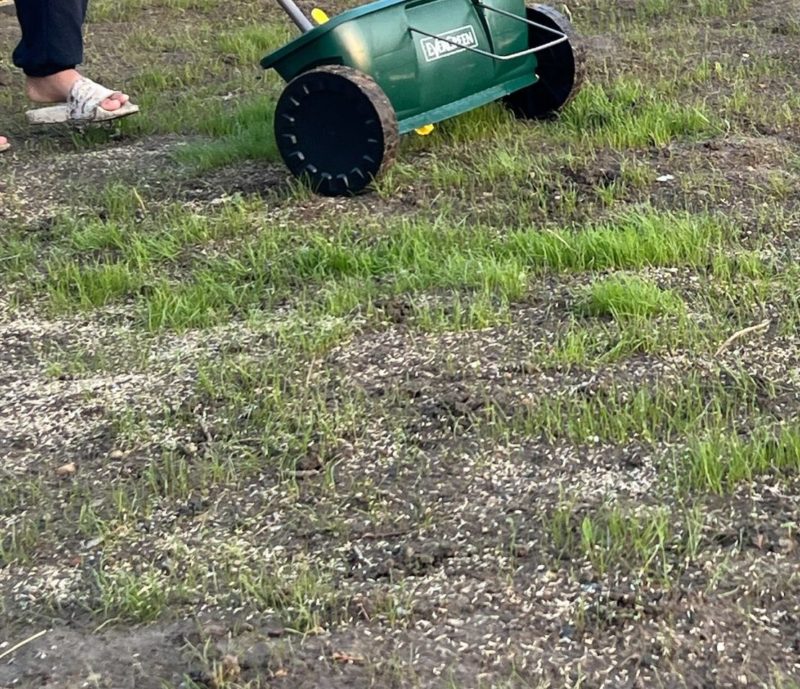
From a height perspective, I am 5 foot 9, I had no problem using this, my daughter considerably shorter, again no problem, it’s more about the angle change.
All being said, this is the best lawn feed spreader from testing, especially when you consider the price. It has a good hopper capacity and is easy to get a uniform spread of feed or seed on your lawn, once you get to grips with the walking pace, and a few other little quirks.
What I definitely appreciated though was the stand. I can just rest the spreader upright whilst I load it with seed – without the stand I would be pulling my hair out. Here’s a picture of what I mean:
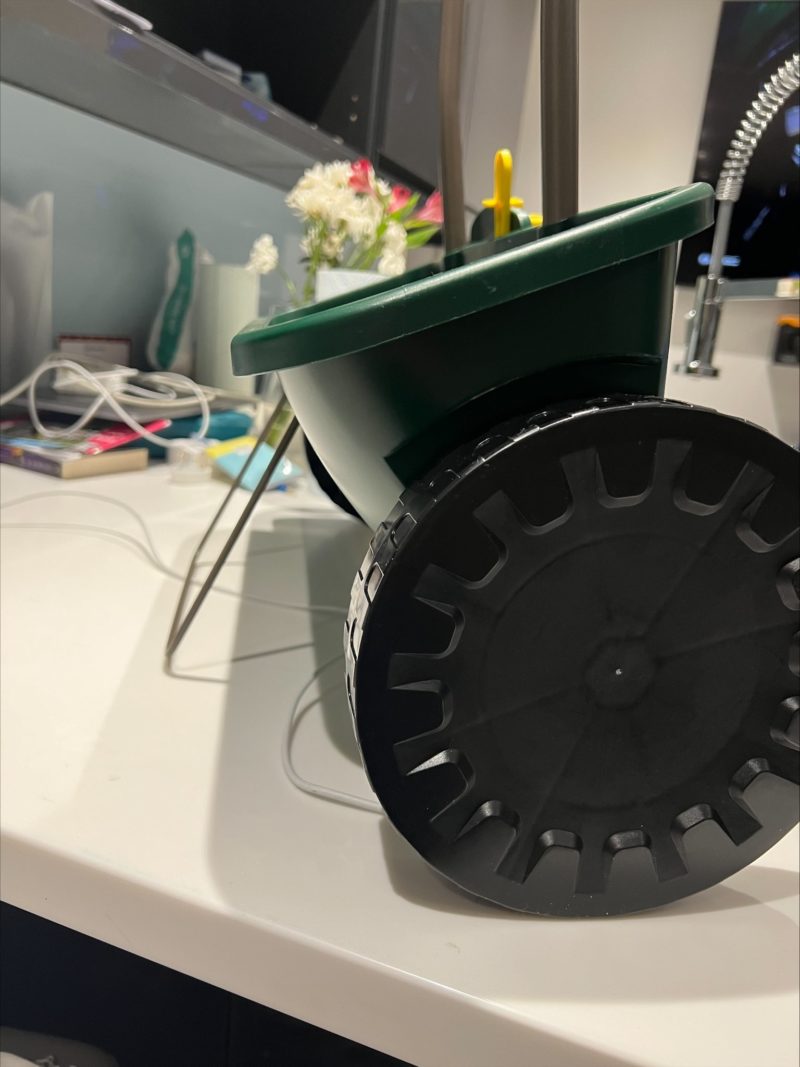
In terms of capacity I have laid in easily a good couple of kilo of seed, maybe even two! – reloading every few minutes doesn’t feel a burden at all when you’re covering so much ground:
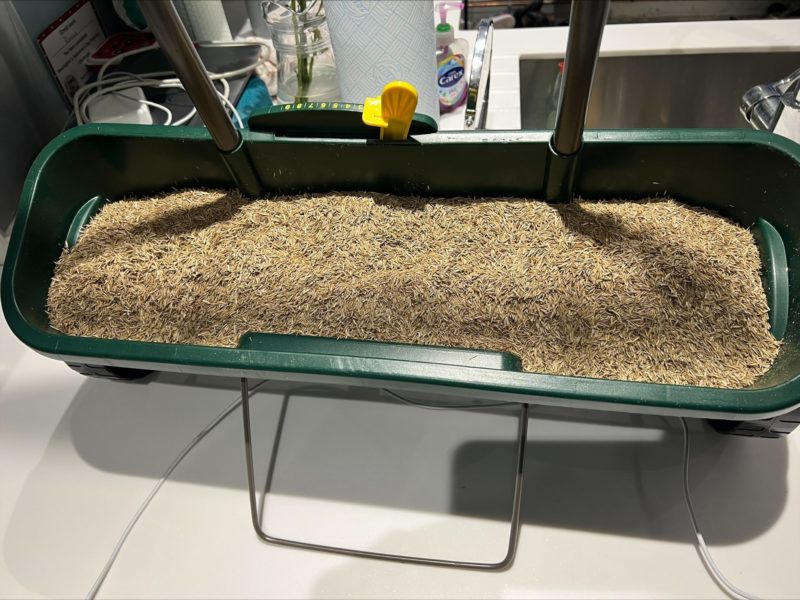
You just can’t go wrong really – There’s no way you can justify the extra of the Scotts when you compare the price and how much you’ll use it, unless it’s for commercial purposes. Then read on to the Scotts lawn spreader as I compare and test them.
Summary:
Providing better quality than I would have expected for the low price, the EverGreen 18920 Easy Spreader Plus offers you a good alternative to the Scotts spreader. Very easy to assemble, and having a decent-sized hopper capacity, there are a lot of things to like about this product. Just make sure you oil the wheels regularly.
2. Scotts EasyGreen Rotary spreader
Specification: Spreading width: 122-340 cm, Capacity: N/A, Recommended lawn area: least 100 m², When to use: March to November
If you have a larger lawn, a rotary spreader (sometimes called a broadcast spreader) is definitely one of the ways to go about your lawn feed distribution, and the Scotts EasyGreen model is one of the most popular products in this category.
These kinds of spreaders will automatically throw out and granular feed as you push the tool along across your lawn, and will increase the width of this the faster you walk. At an average pace, the spreading width is around 150-180cm, but it can be as much as 340cm with a little effort.
Scotts EasyGreen rotary spreader arrives ready to use with no assembly required on your side. All that’s needed is to fill the tank with feeder, adjust the variable settings using the controls on the handle, and you are ready to feed your lawn.
The manual that comes with this spreader isn’t the best quality but it does give you the best settings to use for various products, which is very helpful if this is your first lawn feed spreader.
Throughout our tests this model didn’t get jammed a single time, I think due to the hole where the feed goes through onto the spinning component as it is larger than what you sometimes see with these kinds of products.
The construction is a mix of metal and plastic, with plastic wheels and tank fixed onto metal handles. The handles can be folded down for storage purposes but unfortunately, the height of them can’t be adjusted. Having said that, they come up about a metre tall, so it’s not like they are overly short to begin with.
Completely empty the spreader weighs in at 3.4kg but even with a full load of feed it doesn’t feel cumbersome and my wife found it very easy to use despite being only 5.5ft and being a dainty little thing.
I think the plastic wheels do a good job of keeping the lawn feed spreader rolling along. I would have preferred to see pneumatic wheels but I know that that would have almost certainly increased the price, so I get why Scotts chose what they did.
There is an on/off trigger that comes in very useful when negotiating the corners of your lawn and if used properly will prevent you accidentally dumping too much feeder in one spot which could have adverse effects.
This product isn’t perfect, and there are a couple of little niggles such as it being hard to get the last bit of feeder to fall through the hole due to the shape of the feeder, not being able to use it for spreading road salt, and the fact that it takes a while to get the settings and walking speed right.
However, it is still a very good lawn feeder spreader for the price and if used as intended, it does a great job.
Summary:
A great lawn feed spreader for larger gardens, the Scotts EasyGreen Rotary spreader does an amazing job of scattering the contents of the hopper far and wide. It is easy to push along, solidly built, and you won’t have to stop every five minutes to unblock the holes. Apart from the fact you can’ use it for road salt, I have nothing but praise for this product.
3. Einhell GE-US power X-change spreader
Specification: Spreading width: 5 metres, Capacity: 3.3 liters, Recommended lawn area: up to around 800 m², When to use: year-round use
While most lawn feed spreaders are quite basic tools, with few moving parts, there’s nothing wrong with going a bit more ‘hi-tech’ with the Power X-change feeder from Einhell.
This lawn feed spreader is a part of Einheell’s Power X-change range of products, and so, is powered by the same 18V lithium-ion battery as other products in the range. What this means is, that if you already own one of these, or you are thinking of buying more in the future, you can use the same battery for multiple tools.
The Einhell spreader gives the user a lot of control over both the speed (6 settings) and spread volume (8 settings) and is a great time-saving tool for smaller gardens.
Like with most lawn feed spreaders, you are not only limited to using lawn feed, but also other granular products such as grass seed, and even grit or salt for when Jack Frost has made your garden path or driveway a bit tricky to navigate.
The hopper in this product can hold up to 3.3 litres of granules, which is good for an area of about 15 square metres, so if you have a large garden you’ll either have to do a few refills or perhaps look for a bigger product like one of the Scott wheeled feeders featured on this page.
Of course, the downside to any battery-powered tool is that the battery will eventually run out, but these days it is not as bad as it once was, with even the smallest 1.5Ah Li-ion batteries giving you a good couple of hours of usage on a single charge.
Please be aware that the battery and charger don’t come with the feeder as standard, and you will have to pay extra for them, quite a bit extra actually, and that is the biggest flaw of the Einhell Power X-change feeder. It’s an excellent product and gives you a really even and uniform spread. It is also very easy to use and requires no physical shaking or turning of handles either. However, it is quite expensive when you compare it to other handheld lawn feed spreaders, and I think that unless you have money to burn, or you plan on using more tools from the same range, the price might put you off.
Summary:
The only battery-operated handheld spreader that I’ve ever tried, the Einhell GE-US Power X-Change Lawn Feed Spreader didn’t disappoint, offering effortless dispersion of lawn feed and seed, and giving you an excellent level of control over everything you spread too. This is very comfortable to hold in the hand, despite having the extra weight of the battery, and apart from the higher than average price tag when compared to other spreaders, there is nothing not to like about it.
4. Gardena Hand-Held Spreader
Specification: Spreading width: 1-4 metres, Capacity: 1.8 liters, Recommended lawn area: up to around 100 m², When to use: year-round use
From a lawn feed spreader designed for bigger gardens, to one for those smaller lawns now with the Gardena hand-held spreader.
As you probably guessed by the name of the product, this spreader has been designed to be held in the hand and so has compact dimensions and very little weight. To be perfectly accurate, it measures 29cm high, 22cm long, and just under 20 cm wide, and weighs in at 610 grams.
Because of its small size, it can’t hold large quantities of fertiliser so even a full tank would only add about another 1.6 kilograms to the weight you need to carry, and even young kids could handle that easily.
The Gardena features a good-sized carry handle that has two of the main controls situated on it. On top is a button you press with your thumb to open up the hole and allow the contents to flow through to the spreading mechanism, and on the front of the handle is a selector switch with four settings that controls how much fertilizer will be allowed to pass through when the thumb button is pressed.
On the right side, you will find a crank handle which you turn to operate the rotating disc housed under the tank. The spread isn’t overly far (1-3 metres depending on the crank speed I would guess), but it isn’t meant to be, and what it does do very well is distribute it nice and evenly in all directions (except backward of course).
And it’s not only fertiliser that can be used with this spreader. You can also use it for distributing road salt on your drive and path in winter, for spreading seeds, and even sand.
Gardena products are known to be well made and this lawn feed spreader is yet another robust and durable gardening tool to add to that list. The plastic used is nice and thick and feels very strong, and there is a 2 year warranty to give you peace of mind just in case.
If you only have a small lawn, and don’t mind walking around a little to spread your fertiliser, you could do a lot worse than spending a few quid on this handheld Gardena lawn feed spreader.
Summary:
Living up to Gardena’s excellent reputation isn’t easy, but this Gardena Hand-Held Spreader knocks it out of the park, combining solid build quality with an ease of use that has made it a very popular product for people with smaller gardens. Its small hopper might put you off if you have a huge lawn, but for a lot of people this is the product of choice, and I see why.
5. The Handy 50lb Wheeled Lawn and Fertiliser Spreader
Specification: Spreading width: 3.05-3.66 metres, Capacity: 23 kg, Recommended lawn area: up to around 100 m², When to use: year-round use
Looking for something a bit more heavy-duty? The Handy 50lb wheeled lawn and fertiliser spreader is among the most solid and sturdy models I’ve ever come across and would suit someone who has a medium to large-sized lawn, particularly if your lawn is on a slope or you have uneven terrain to negotiate.
This is because of this lawn feed spreader’s most outstanding features, the large and wide pneumatic wheels. They do an excellent job of keeping the weight balanced as you move along, and really do a good job of making working up slopes a much less labour intensive task.
The largely steel construction has been powder coated to fight off adverse weather effects, and has been done to a high quality and should last. The frame itself feels very strong too, so you can forgive the extra weight that comes with it, and with those pneumatic wheels doing their job, you don’t notice it that much anyway.
Just in front of the wide, rubber gripped, handles there is a good-sized, and clearly marked spread rate adjustment lever. This too is made of strong steel, but with a plastic grip for comfort, and is highly unlikely to become damaged or worn any time soon.
With a hopper that can hold 23 kilograms of feed, you shouldn’t have to keep stopping to refill too often, nor do you have to worry about clog-inducing contaminants getting mixed in there thanks to a hopper screen and hopper cover being included in the price. This means you can even use it in wet weather, as long as you have a good set of wellies and a raincoat.
The hopper has been made out of polypropylene for durability reasons and is a very resilient and hard-wearing material in of itself, so there’s no reason why it shouldn’t last as long as the rest of this robust tool.
The maximum spread width of The Handy lawn feed spreader is around 3.6 metres, so you could quite feasibly cover a good-sized lawn without it taking all day. This would mean keeping up the walking pace though, as you probably know.
So, what are the negatives? Well, I can only really find one, but it might be enough to put some people off.
The thing is, that this lawn feed spreader comes in quite a lot of different parts and takes a while to assemble. Not only that, but the instructions aren’t the clearest on some of the assembly points and it does lead to a little frustration.
A little perseverance and patience saw me through it though, and I was very pleased with the fully assembled product at the end and thought it was worth the effort.
Summary:
Larger lawns are rarely completely flat, and so having a good set of wheels on your lawn feed spreader is a must. With the The Handy 50lb Wheeled Lawn and Fertiliser Spreader being fitted with pneumatic tyres instead of plastic ones, you can be sure to get around your garden with relative ease, no matter how many little hills and troughs you have. Assembly isn’t the easiest thing due to poor instructions, but once built, this is an excellent tool that is built from robust and durable materials.
6. Scotts EvenGreen Drop spreader
Specification: Spreading width: 45 cm, Capacity: N/A, Recommended lawn area: least 100 m², When to use: March to November
If, after reading the end of that previous review, you think you would prefer something that is much simpler to put together, the Scotts EvenGreen drop spreader might be something that piques your interest.
Arriving almost fully assembled, you can have this lawn feed spreader out of the box and on your lawn in a matter of minutes.
Unlike our other Scotts product review, this one is a drop spreader and works in a slightly different way. Where a rotary spreader will use a turntable to throw the fertiliser, weed killer, etc. out in multiple directions, a drop spreader distributes the contents of the hopper straight down.
This has both advantages and disadvantages when compared with a rotary spreader. The downside is that you won’t cover as much ground as quickly as a rotary spreader and that’s why most people don’t recommend using drop spreaders for large areas. Having said that, this one is 61cm wide and would be able to cover a decent bit of ground.
The advantage of a drop spreader is that you have much more control over where the contents are being put down, and this makes them better for using on the edges of lawns or near garden ponds so you don’t contaminate the water accidentally with chemicals.
Apart from the spreading function, the Scotts Evergreen drop spreader is very similar in design to its sibling, with a large plastic hopper and plastic wheels mounted on a metal frame and handles.
The trigger to operate the tool is situated on the centre of the handlebar and below that are the variable distribution controls that are clearly marked, if a little on the small side, just like the rotary model by the same makers.
This model also features the folding handlebar to make storage easier and to get a comfortable working angle, but again, the height can’t be changed.
However, don’t let those little things put you off, as this is a great little drop spreader and priced very reasonably.
The spreading mechanism works really well and there is no feed getting flicked out in unwanted directions and being wasted. Instead, you get a nice uniform distribution of whatever you are using on your lawn, and that’s where it goes, on your lawn, just where you want it.
Summary:
Just like with their rotary spreader, Scott has come up trumps again with this large drop spreader that is solidly built, and perfect for a larger garden, but where care needs to be taken. The drop feeding action ensures that you don’t accidentally get feed in your garden pond or flower beds, while the 61cm width of the tool makes sure you can still get the job doe quickly. You can’t go wrong with the Scotts EvenGreen Drop spreader.
7. Gardena Spreader XL: Universal Spreader for Delivering Fertiliser
Specification: Spreading width: 1.5-6 metres , Capacity: 18 liters, Recommended lawn area: up to around 800 m², When to use: year-round use
There are some of us who would prefer to use a rotary spreader but only have a small garden and are worried about getting unwanted chemicals in places we don’t want them. Even when walking at the slowest pace, the larger broadcast spreaders still distribute the contents of the hopper and some distance and it can be hard to control where it goes in a small or narrow yard.
This is where the Gardena Spreader XL comes into its own, giving you the ability to control the spread width to a high degree and allowing you to tackle both small and medium-sized gardens alike.
It features an adjustable guard on the rotary table that you can easily slide around and this blocks any lawn feed from being sent out in that direction. This makes it a great tool for using on the edges of lawns that are next to flower beds and such.
The feeder hole in the bottom of the 18 litre capacity hopper is opened and closed using an ergonomically designed trigger found on the handlebars. I really liked the way this worked and felt very natural when you used it.
I was not so happy with the controls to adjust the spreading quantity though, which is something you have to grab and slide across the bottom of the trigger. It’s not that it doesn’t work, or is particularly that bad, I just think it could have been done better, as it is in many other lower-cost products, and I expected more from a brand like Gardena.
Where Gardena has lived up to their name is with the overall build quality of this lawn feed spreader, which is excellent.
Because of the corrosive nature of the products used in these feeders, the hopper and other parts that come into contact with the chemicals are usually made of plastic. Gardena only ever uses the most durable ABS plastics for their products, and it is the same again with this one.
The durability of this plastic means that you can use many kinds of fertilisers, sand, strong weed killers, yes, even the type of weedkiller for your patio and block paving as well as rock salt without worry.
This product also features an aluminium bracket, a material that is known to be extremely resistant to corrosion and rust, and will help to prolong the working life of the tool.
Another feature I thought was a good addition was the lower stand that made refilling the hopper so much easier, and I never felt like it was going to tip out under the weight of the feed.
A good choice for Smaller lawns where you have to be careful about the spread, and top-class quality materials make this Gardena product well worth a look.
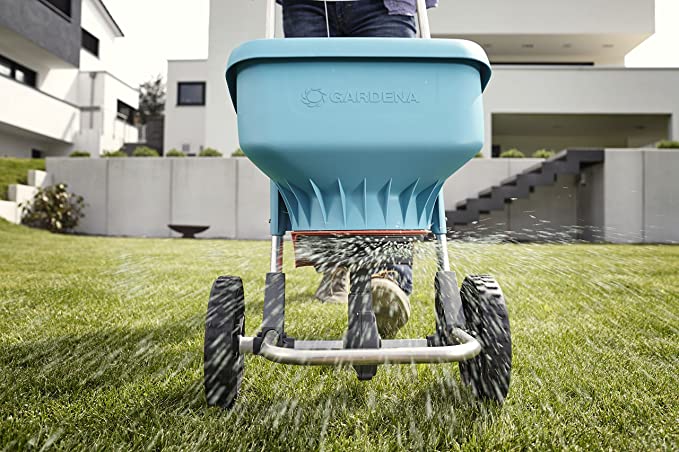
Summary:
A rotary lawn feed spreader that gives you a higher degree of control over the spread, Gardena Spreader XL: Universal Spreader for Delivering Fertiliser gives people with small to medium-sized lawns the convenience of using a rotary spreader without the risk of contaminating other parts of the garden. What’s more, it has an excellent build quality and can be used with a wide range of feeds, and other garden chemicals.
8. Greenkey Deluxe Seed and Fertiliser Spreader
Specification: Spreading width: N/A (very small), Capacity: 3 liters, Recommended lawn area: least 100 m², When to use: N/A
Our final review of today is of another handheld lawn feed spreader, this time from Greenkey.
People tend to go for these kinds of spreaders because they are low cost, easy to use and there is less chance of accidentally putting too much fertiliser down and killing off parts of your lawn.
The Greenkey deluxe seed and fertiliser spreader is certainly easy to use, with minimal controls and no tedious assembly required. In fact, the only controls you have to deal with are the four aperture settings which are selected using the switch on the handle with your thumb, and the crank handle on the side to operate the spreading mechanism.
Holding this spreader for extended periods isn’t a chore as it only weighs around 550 grams, and even when the hopper is filled to its 3 litre capacity, it is hardly what you would call heavy.
However, if you do find that your wrist is getting a little tired, Greenkey has included a handy little design feature to help out. On the back of the handle, there is a part that can be pulled out and extended to create support for your forearm, and it even has a wider flat part at the end so that your arm can sit comfortably on it.
This is a simple but clever design feature, and the type of thing I like to see product makers trying out instead of just making carbon copies of other top-selling models.
To avoid damage from corrosion, the Greenkey handheld spreader has been made completely out of high-grade plastic that feels very thick, robust, and made me feel that this product would last a fair old while.
As always, there are things I didn’t think were so great. For example, the handle that you turn on the side to operate the spreader is very small and has to be pinched between two fingers. I would have much preferred a decent-sized handle like on the Gardena handheld model instead.
There also doesn’t seem to be that much difference between the four different spread settings. I mean, there is some difference, but not enough to make it really worth having it there in the first place.
These are small gripes though, and I shouldn’t complain too much about something that costs under fifteen quid, and overall it is a good little spreader and certainly worth a look.
Summary:
Easy to set up and use, and with the handy little arm support feature that will please a lot of people after a long day’s reseeding or lawn feeding, the Greenkey Deluxe Seed and Fertiliser Spreader is another excellent option. Not a perfect product, as the spread controls aren’t the most accurate, but it is a low-cost model that does its job well.
What is a lawn feed spreader?
To keep a lawn tip top you need the right lawn spreader. You’ve got to prep the soil, keep on top of lawn aeration for which we can use a decent scarifier or raker these days, you need to get rid of any unwanted weeds with a weed killer if you prefer (preferably a weed killer that is tested on pets), before they become a problem, and many more tasks just to have a chance at that dream patch of grass.
One of the most important factors is to make sure you are feeding your lawn all the necessary things it needs to grow into something comparable to a bowling green. And to do this right, you should really be using one of the best lawn feed spreaders to ensure that your lawn weed and feed are getting evenly distributed and giving your grass the best chance to flourish.
You could think of a lawn feed spreader as a wheelbarrow with holes but much more sophisticated at evenly spreading. A lawn feed spreader is a tool used to help you spread lawn feed faster, and more evenly than you could, just using your hands. Whether it is a small, handheld lawn feed spreader, or a larger version that is mounted on wheels, they basically made up of some kind of container that you fill with seeds or feed and a section that is used for dispersing the contents around your garden. It is important to note that these products are only meant to be used with granular lawn feed, so if you are planning on using a liquid-based fertiliser, you’d be better off shopping for a good garden sprayer or watering can instead.
How to use a lawn feed spreader
No matter which type of lawn feed spreader you’re using, they are all very easy to operate. All you need to do is adjust the spread rate to suit your needs, then fill the container section up with your lawn feed and disperse it on the area that needs it. However, not all models use the same dispersing technique, and if you go to our Best lawn Feed Spreaders Buyer’s Guide, you’ll see how we compare rotary lawn feed spreaders with drop lawn feed spreaders.
Types of lawn feed spreader
The type of garden feeder you will need will depend a lot on the size of your garden and what you intend to do within it. People with smaller lawns can easily get away with one of the best handheld lawn feed spreaders as there isn’t too much ground to cover, but those of you who are lucky enough to have much larger properties will probably need a rotary spreader or even one that you pull behind a tractor or ATV.
We took a selection of the best lawn feed spreaders and put them to work to test out for ourselves if they are really worth the money. You can find out what we thought by reading our selection of in-depth reviews below. For those seeking more information and guidance, please check out our Best lawn Feed Spreaders Buyer’s Guide to get a better idea about what to look out for in a top lawn feed spreader product.
Best lawn Feed Spreaders Buyer’s Guide
Should you go with a rotary/broadcast spreader or a drop spreader?
Maybe you could just do with a small handheld model?
What are the best features to look out for when choosing a lawn feed spreader?
Read on below and our buyer’s guide will try to provide the answers to these questions and more.
Comparing the types of lawn feed spreader
There are a few different types of spreaders but they can usually be broken down into two specific groups- rotary spreaders and drop spreaders.
Rotary like the Scotts EasyGreen Rotary spreader, or broadcast spreaders as they are also known, use a rotating table that is located under the hopper to distribute the feed in a wide arc, thus covering a large area at once, and this makes them a good pick for larger lawns. Here’s a look at a typical garden rotary lawn feed spreader, the Scotts EasyGreen Rotary spreader (our overall winner).
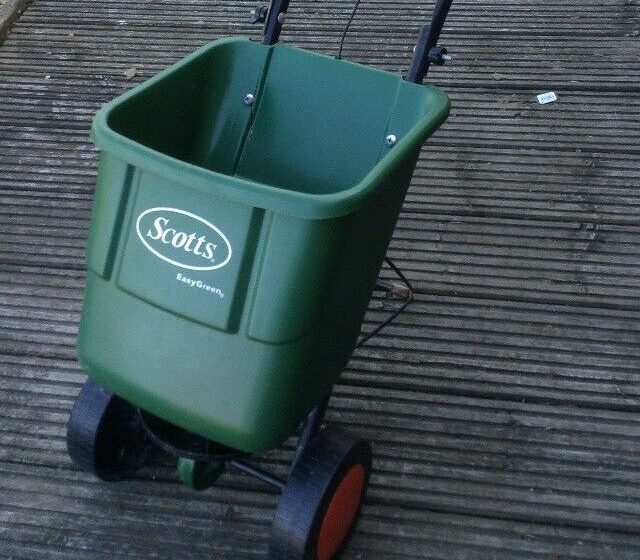
If you have a larger than usual lawn, you might want to consider a tow-behind spreader that you can pull with a quad or small tractor.
Drop spreaders, as you can guess, ‘drop’ the fertiliser straight down and not out to the sides. While this makes them a little slower to cover the same area when compared to a rotary model, it also makes controlling where the feed goes much easier. This is particularly useful for smaller gardens, and for working on parts of the lawn that are next to vulnerable areas such as flower beds and ponds.
Another variation of the rotary type is the handheld spreader. These are lightweight, low cost, and very easy to use, and if you only have a small space to cover, they can be a great tool to use. recently, there have been battery-operated handheld lawn feed spreaders coming onto the market, like the Einhell GE-US Power X-Change Lawn Feed Spreader, and when compared to the standard handheld spreaders, they take much less physical effort to use. You will have to pay extra for that privilege though.
Variable controls
Many feed spreaders these days have controls, usually on the handle, to select how much fertiliser, granules, etc. is allowed to flow through the hole in the bottom of the hopper when the trigger is pressed. Here’s a look at a handheld lawn feed spreader with variable controls.
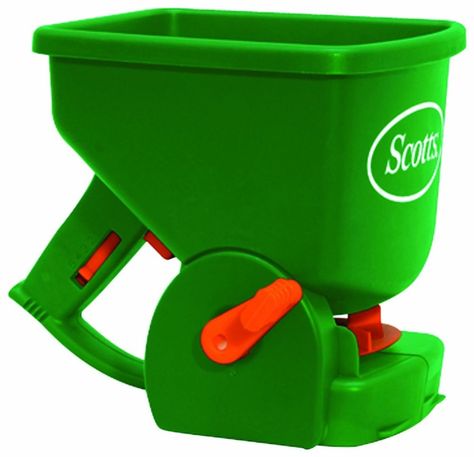
These selector switched are often varied in design, and will also perform differently from model to model, so I would suggest reading customer feedback and reviews on the products you’re interested in to see if anyone mentions any problems with this.
Ergonomic design, weight, and wheels.
If something is ergonomic, it means that it has been designed to fit with the human body’s shape in the most efficient and comfortable way. Some products have better designs when it comes to this, and it will make a difference to you if you are using the tool for long stretches of time, so look for a good one.
Generally speaking, if something like a handle is too straight, and without any curvature, it tends to be a bad sign. Of course, handlebars are an exception to this, but for handheld spreaders, this is something to look out for.
Weight is another factor to consider, especially if you’re thinking about a handheld spreader. You don’t want something that weighs a ton in your hands all day.
Even walk-behind spreaders can be a bit of a struggle to push uphill when their hoppers are full if they don’t have a good set of wheels. Plastic wheels can be just fine but for me, pneumatic wheels are the best choice as they negotiate slopes and uneven ground better.




























